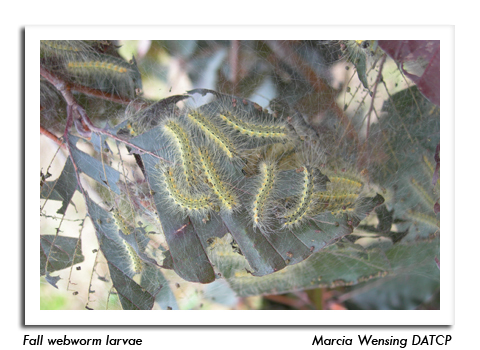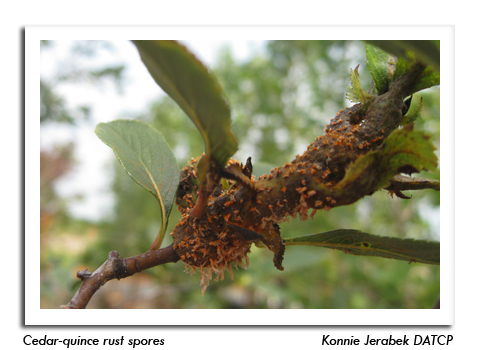
 |
|
|
Nursery & Forest
Volume 58 Number 14 Date 08/08/2013 FALL WEBWORM - Webs constructed by the larvae of this pest are conspicuous on alder, aspen, birch and other host trees statewide. Fall webworm is a native species that feeds on a wide range of deciduous forest, shade, fruit, and ornamental trees. Its characteristic webs appear at this time of year, later than nests made by other web- and tent-making species found in Wisconsin. This pest is primarily a cosmetic problem that can be controlled by removing and destroying the web. Insecticides or Bacillus thuringiensis (Bt) products are also effective against small larvae. Fall webworm feeding rarely results in severe or long-term damage and populations are usually regulated by more than 50 different species of parasites and 36 species of predators. CEDAR-HAWTHORN AND CEDAR-QUINCE RUST - Symptoms of cedar-hawthorn and cedar-quince rust are appearing on hawthorns throughout the state. In the case of cedar-hawthorn rust, bright orange leaf spots are evident on the leaves, while cedar-quince rust is infecting the fruits and twigs. Both rust diseases require two hosts to complete their life cycles: a rosaceous host such as hawthorn and a juniper host. Selecting resistant hawthorn cultivars and thorough sanitation (removing as much of the infected twigs, fruit and leaves as possible) are the recommended controls. Fungicide treatments applied as new growth appears and flower buds start to open may be justified for severe cases. BIRCH ERINEUM GALL - Nursery inspectors identified the reddish-pink, felt-like patches appearing on river birch leaves in Ozaukee County as birch erineum galls. The galls are caused by tiny eriophyid mites and have no impact on tree health. Control is not necessary. GYPSY MOTH - The DNR Northern Region Forest Health Specialist reports that defoliation by this pest was generally less severe than expected in northern Wisconsin this season. Moderate defoliation of aspen stands occurred in Ashland and Florence counties, while damage in parts of Bayfield County was light. A number of homeowner inquiries were received concerning large infestations of caterpillars, but in all cases follow-up inspections found most of the larvae were dead or dying as a result of disease promoted by cool, wet spring weather. Due to the extensive larval mortality, major problems are not anticipated in these areas in 2014. SPRUCE BUDWORM - This conifer pest has also been less of a problem than anticipated. Larvae did not defoliate thousands of spruce and fir acres in northeastern Wisconsin, as DNR foresters had predicted. Considerable balsam fir mortality did occur in a few Florence and Forest County townships, but the death resulted from infestations in previous years. The decline in larval populations was likely influenced by low temperatures and excessive rain this spring. -- Liz Meils, DATCP Nursery Inspector 



|
|
|